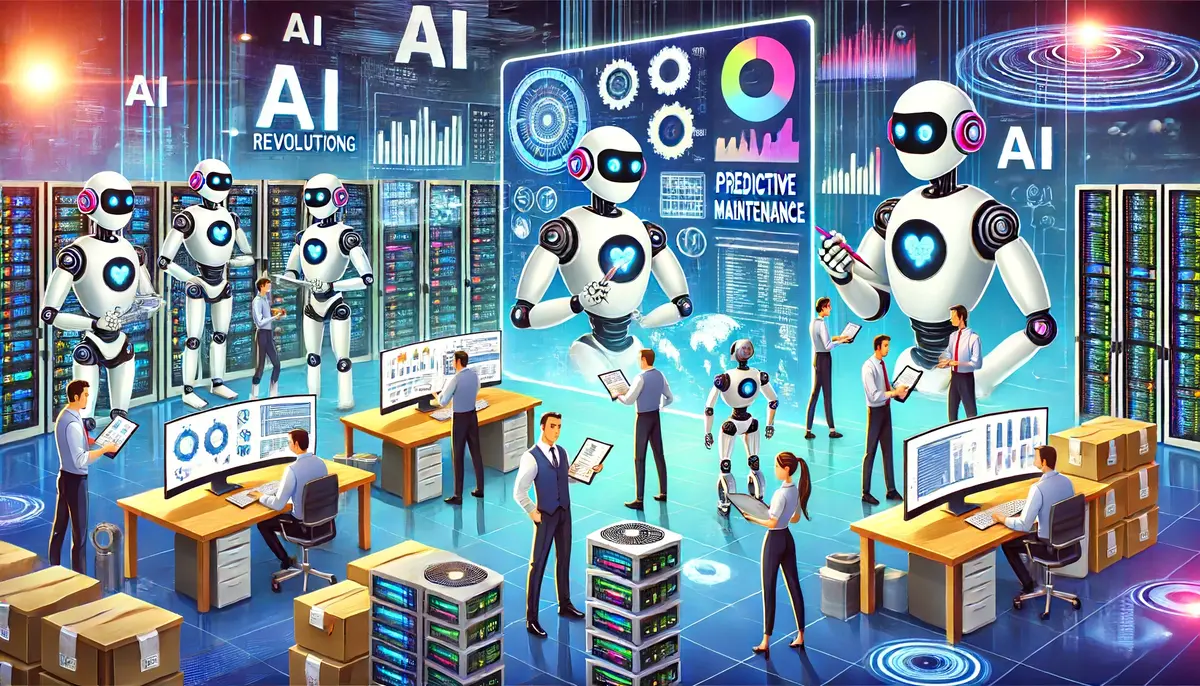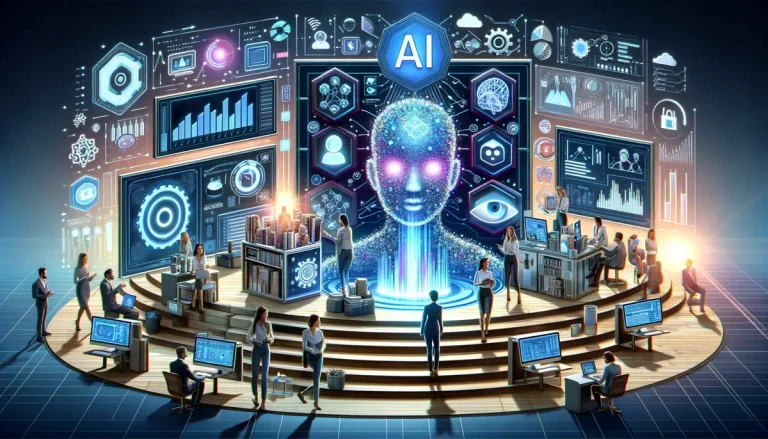AI is making waves across various industries. IT is experiencing significant transformation. AI is a powerful tool reshaping how IT departments function, enhancing efficiency, security, and overall operational effectiveness.
This blog explores how AI for IT operations work and provide a roadmap for businesses to harness its potential.
Care to save 90% of your call center costs?
Learn More Here
Understanding AI in IT
AI’s journey in IT is a fascinating tale of technological advancement. Initially, AI was seen as a futuristic concept, something confined to science fiction. However, over the past few decades, it has evolved from simple rule-based systems to sophisticated algorithms capable of learning and adapting. The evolution of AI in IT can be divided into three key phases:
- Basic Automation: In its infancy, AI was used for automating repetitive tasks, such as data entry and basic system monitoring.
- Machine Learning Integration: As machine learning (ML) techniques advanced, AI systems began to learn from data, making predictions and improving over time. This phase saw the rise of predictive analytics and smart automation.
- Deep Learning and Beyond: Today, deep learning (DL) and neural networks have brought AI to new heights, enabling systems to understand complex patterns, process natural language, and even recognize images.
Key AI Technologies in IT
- Machine Learning (ML): ML algorithms allow IT systems to learn from historical data and improve their performance without explicit programming. For instance, an ML algorithm can predict system failures by analyzing past performance data.
- Natural Language Processing (NLP): NLP enables machines to understand and respond to human language. This technology is used in chatbots and virtual assistants, making interactions with IT systems more intuitive.
- Deep Learning (DL): DL uses neural networks to process large datasets and identify intricate patterns. It’s crucial for tasks like image and speech recognition, enabling more advanced IT solutions.
- Robotic Process Automation (RPA): RPA uses AI to automate mundane, repetitive tasks across IT systems, enhancing operational efficiency and accuracy.
The Benefits of AI for IT Operations
Here are some common benefits of AI for IT operations:
Enhanced Efficiency and Productivity
AI significantly boosts efficiency in IT operations by automating routine tasks and processes. This allows IT professionals to focus on more strategic initiatives rather than getting bogged down with repetitive work. Here’s how:
- Automation of Routine Tasks: AI automates tasks such as software updates, system monitoring, and data backups, reducing the manual workload on IT teams.
- Intelligent Workflows: AI can create intelligent workflows that adapt to real-time changes, optimizing processes dynamically.
An AI system can automatically deploy patches and updates across multiple servers without manual intervention, ensuring systems remain secure and up-to-date with minimal downtime.
Improved Accuracy and Reduced Human Error
AI systems are designed to analyze large volumes of data with precision, significantly reducing the likelihood of human error. This is particularly beneficial in areas such as quality assurance, where accuracy is critical.
- Data Analysis: AI tools can analyze log files, network traffic, and other data sources to identify potential issues before they escalate.
- Predictive Maintenance: AI predicts equipment failures by analyzing usage patterns and historical performance, allowing for proactive maintenance.
An AI-driven quality assurance tool can test software applications for bugs and vulnerabilities more comprehensively than human testers, leading to more reliable products.
Real-Time Monitoring and Predictive Maintenance
AI’s ability to process and analyze data in real time allows for continuous system monitoring and proactive maintenance. This means IT teams can identify and resolve issues before they impact users, improving system reliability and performance.
- Proactive Issue Resolution: AI systems can monitor system health and performance metrics in real time, alerting IT teams to potential issues before they cause disruptions.
- Predictive Analytics: AI uses predictive analytics to forecast potential system failures or performance bottlenecks, allowing for timely interventions.
AI-driven predictive maintenance can forecast hardware failures, enabling IT teams to schedule repairs during low-impact periods and avoid costly unplanned outages.
Cost Savings and Return on Investment (ROI)
By automating tasks and enhancing efficiency, AI can lead to substantial cost savings for IT departments. The ROI from AI investments often includes not only direct financial benefits but also improved performance and user satisfaction.
- Reduced Operational Costs: Automation reduces the need for manual labor, cutting operational expenses.
- Enhanced Resource Allocation: AI optimizes resource allocation by identifying inefficiencies and suggesting improvements.
A business that implements AI-driven automation in its IT support operations can reduce costs by minimizing the need for human intervention and improving overall efficiency.
Key Applications of AI in IT
Here are some key applications of AI in IT:
IT Service Management (ITSM)
AI enhances IT Service Management by providing intelligent tools that streamline support processes and improve user experiences. AI-driven ITSM solutions can handle routine service requests, perform diagnostics, and even provide automated resolutions.
- Chatbots and Virtual Assistants: AI-powered chatbots can handle common IT support queries, such as password resets and software installations, reducing the workload on human agents.
- Automated Ticketing: AI systems can automatically generate and manage support tickets, prioritizing issues based on urgency and impact.
An AI virtual assistant can guide users through troubleshooting steps for common issues, freeing up IT staff to focus on more complex problems.
Network Security and Management
AI plays a crucial role in enhancing network security by providing real-time threat detection and automated response mechanisms. It can analyze network traffic for unusual patterns that might indicate a security breach.
- Threat Detection: AI systems can analyze network traffic to identify potential threats and anomalies in real time, providing early warnings of security breaches.
- Automated Response: AI can automate responses to detected threats, such as isolating affected systems or blocking suspicious IP addresses.
An AI-driven security system can detect and respond to a Distributed Denial of Service (DDoS) attack by automatically rerouting traffic and blocking malicious IP addresses, minimizing the impact on network performance.
System Monitoring and Performance Management
AI provides advanced capabilities for system monitoring and performance management, ensuring that IT systems operate efficiently and effectively. It can analyze performance metrics and user interactions to optimize system configurations and resource allocation.
- Real-Time Monitoring: AI continuously monitors system performance, identifying potential issues and optimizing resource usage to prevent bottlenecks.
- Dynamic Load Balancing: AI can balance workloads across servers in real time, ensuring optimal performance during peak usage periods.
AI can monitor server loads and automatically distribute traffic to prevent slowdowns or crashes during high-traffic events, such as a product launch or a major sale.
Data Management and Analysis
AI enhances data management and analysis capabilities by providing tools that can process and interpret large volumes of data quickly and accurately. This enables IT teams to extract valuable insights and make informed decisions.
- Big Data Analytics: AI tools can analyze large datasets to identify trends, patterns, and anomalies, providing actionable insights for IT strategy and decision-making.
- Data Governance: AI helps ensure data quality and compliance by automating data governance processes, such as data classification and access control.
AI tools can sift through vast amounts of data, extracting meaningful patterns and trends that inform business decisions and strategic planning.
AI Tools and Platforms for IT
Some tools and platforms for IT? Here are a few for you:
Leading AI Tools
- Salesforce Einstein: Salesforce Einstein provides AI capabilities for CRM and IT operations, offering predictive analytics, automation, and intelligent insights. It integrates seamlessly with other Salesforce tools, enhancing IT service management and customer support.
- IBM Watson: IBM Watson is known for its advanced NLP capabilities and provides a suite of AI-driven tools for IT operations, including predictive analytics, automation, and cognitive computing.
- Google AI: Google AI offers a range of tools for machine learning, deep learning, and data analysis. These tools can be integrated into IT systems to enhance performance, automate processes, and provide real-time insights.
- Microsoft Azure AI: Microsoft Azure AI provides a comprehensive suite of AI services, including machine learning, cognitive services, and data analytics. These services can be used to build and deploy AI solutions for various IT applications.
Features and Capabilities
These tools offer a range of features, including:
- Automation: Automating routine tasks and processes.
- Predictive Analytics: Providing insights based on historical data and trends.
- Natural Language Processing: Enabling intuitive interactions with IT systems.
- Real-Time Monitoring: Continuously monitoring system performance and health.
Comparison and Selection Criteria
When choosing an AI tool for IT, consider factors such as:
- Integration Capabilities: How well the tool integrates with your existing IT infrastructure.
- Scalability: The ability to scale the AI solution as your business grows.
- Ease of Use: The user-friendliness of the tool and the learning curve for your IT staff.
- Support and Resources: Availability of support, documentation, and training resources.
Challenges and Considerations in Implementing AI for IT
There are a few challenges you need to understand prior to implementing AI for IT:
Common Challenges
- Data Privacy and Security: Ensuring that AI systems comply with data protection regulations and do not compromise sensitive information.
- Integration with Existing Systems: Integrating AI solutions with legacy IT systems can be complex and requires careful planning and execution.
- Skills and Expertise: Implementing and managing AI solutions requires specialized skills and expertise, which may not be readily available within existing IT teams.
Mitigation Strategies
- Data Governance: Implement robust data governance practices to ensure data quality, compliance, and security. This includes establishing clear policies for data access, usage, and protection.
- Change Management: Provide training and support to IT staff to facilitate the adoption of AI technologies. This includes developing a change management plan that addresses potential resistance and ensures a smooth transition.
- Strategic Partnerships: Partner with experienced AI solution providers who can offer the expertise and tools needed to implement AI effectively. Look for vendors with a proven track record in your industry and a deep understanding of your specific IT challenges.
Steps to Get Started with AI for IT
Now to get down to business. Here are the few steps you need to get started with AI for IT:
Assessing Readiness
Before implementing AI, conduct an AI maturity assessment to evaluate your organization’s current capabilities and identify areas for improvement. This assessment should cover factors such as data quality, existing IT infrastructure, and staff readiness.
Building a Strategic Roadmap
Develop a strategic roadmap for AI adoption, including clear goals, timelines, and metrics for success. This roadmap should outline the steps needed to implement AI solutions and integrate them with your existing IT systems.
Partnering with AI Solution Providers
Choose AI solution providers that offer the expertise and tools needed to implement AI effectively. Look for partners with a proven track record in your industry and a deep understanding of your specific IT challenges.
Pilot Projects and Scaling
Start with pilot projects to test AI solutions on a smaller scale before rolling them out across the organization. This approach allows you to evaluate the effectiveness of AI tools, gather feedback, and make necessary adjustments.
Care to save 90% of your call center costs?
Learn More Here
Conclusion
AI is revolutionizing IT operations, offering unprecedented opportunities for efficiency, accuracy, and innovation. As AI technology continues to advance, its impact on IT will only grow, making it essential for organizations to embrace AI to stay competitive.
By understanding the benefits, applications, and challenges of AI in IT, businesses can unlock the full potential of AI and future-proof their IT operations.







